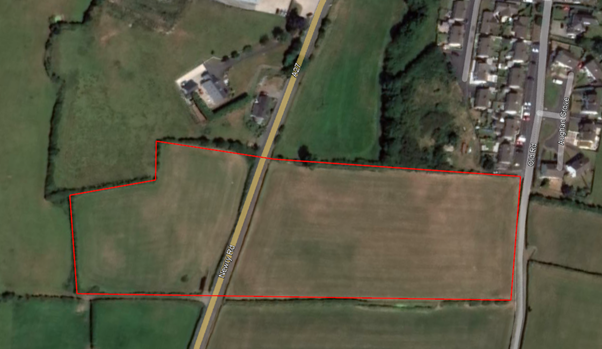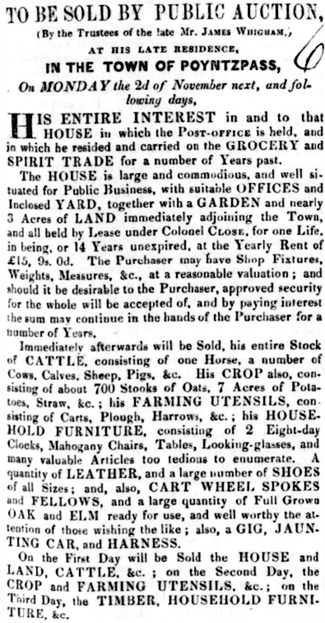We are pretty sure that ‘our’ James Whigham (or Whygam, or Wigham) (1797-1840) was born in Boardmills on 18th March 1797. In 1826 a James Wigham is also listed as one of the two teachers at a school in Poyntzpass, on a salary of about £40 a year, but that salary alone would have not been sufficient to enable him to purchase such a large property without some form of mortgage. In addition, the annual rent would have accounted for over 1/3 of his salary!
We know that by 1828, a James Whigham was at least running a pub on the property; perhaps this was sub-let from Marston? Could a schoolteacher also be running a pub!? Was it a different James Wigham?
In February 1836, James was part of a delegation to Newry Presbytery who were given permission to build a Presbyterian church in Poyntzpass; the foundation stone was laid by Col. Close the following year.
The “Fatal Affray”, Christmas Day, 1828
It was the time of intense and very public debate over the push for Catholic Emancipation, led by Daniel O’Connell. There were two opposing camps in the area, and (as so often in Ireland) little or no common ground between them. The supporters of emancipation were led by Charles Brownlow (MP for Armagh) and the opponents by Colonel William Verner (at the time High Sherriff of Co. Armagh).
On Christmas Day 1828 a fight between pro- and anti-emancipationists erupted in the pub, and James Baird, a Protestant and Verner supporter, was struck on the head with a ‘loaded’ whip[1] wielded John Campbell, and subsequently died.
A whip handle was often weighted with lead shot, to balance it and make its action smoother. But that also meant that the handle could also be used as a cudgel if needed. It was just another form of personal protection in those more lawless times.
Campbell and three others were tried at Downpatrick Assizes, and he was sentenced to 18 months in prison for manslaughter. However, at the same assizes, two men who stole a horse were sentenced to death!
The incident and its aftermath are documented in detail in Hugh Daly’s paper “A Fatal Affair In The Far Pass”, BIF Vol 17 (2022) (not yet available online).
James, The Small Farmer
As well as running the pub (and possibly also being the schoolteacher) James Whigham was also a small farmer; on the 1831 Close Estate map, he is shown as tenant of the 7.5 acres shown below, as well as another 5 acres in Branock close to Acton house.

In the valuation records for cess purposes, carried out in December 1838, entry #18 on the relevant page is “James Whigham, Stores – £8-0-0”. I am certain that this was the canal-side property as entry #15 is “School House – £4-0-0” and #17 is “Lock Keeper’s House – Exempt”. So we know that as well as the pub, James was running a retail business there.
The Searight Connection & A Family Tragedy
James Whigham married Jane Frances Searight (1810-1879) around 1835. Jane was the first child of Edward Searight (1805-1873) and Elizabeth Durney? (born about 1803). Edward is recorded as being a publican in Poyntzpass in 1839 and was later the cess (rates) collector for the Poyntzpass division of the Newry Union.

The Newry Telegraph of 23rd August 1853 reported…
James and Jane quickly had four children – Agnes, Richard, Jane, and James junior – but then tragedy struck the Whigham family repeated blows in 1840-41.
- 27th September 1840 – James senior dies aged 43.
- 20th January 1841 – son Richard dies, aged 4.
- 31st January 1841 – daughter Jane dies, aged about 3.
- 2nd February 1841 – son James dies, aged just 4 months.
So, in just over four months, Jane buried 4/5 of her immediate family! Given that all the three young children died within such a short time – a mere 13 days – it has the hallmark of an epidemic of a devastating childhood disease such as diphtheria.
But why just then? There is no mention in the newspapers of any sort of epidemic in the village (or wider area) at that time. Is there another explanation?
Jane Quickly Sells Everything

Very soon after James senior’s death, an advert dated 15th October 1840 appeared in the Newry Commercial Telegraph announcing the imminent sale by auction of what seem to be everything James owned – the premises, his livestock, his farming implements, house contents, crops (both standing and still in the ground), jaunting car etc.
So, the retail business was a grocer’s shop in addition to the pub, and a post office was also ‘held’ on the premises. The earliest mention I can find for a Post Office in Poyntzpass is an advert on 20th May 1837 in the Newry Telegraph. Given that there was no railway yet, it seems a little odd that the post office had not been established on the main street.
Why did Jane need to sell up so quickly? With no husband, it was obviously impossible for her to continue to farm, and she had no way to get the harvest in; the crops – corn and potatoes – needed to have a new owner if they are not to rot in the fields.
Note the phrase “all held by Lease under Colonel Close”. This implies that the property itself, not just the fields, was leased from the Close estate and not owned by the Whighams. This seems to confirm that it was Col. Close who bought the premises in 1831.
Jane Moves Out
We must presume that Jane moved out of the property after James’ death in 1840 and the auctions. However, in September 1859 Jane re-acquired the property from Maxwell Close. She was now aged 49, and alone in the world. Her only surviving child, Agnes, had died in 1856 aged just 19.
We have no idea how or why Jane was able to buy such a large property, nor how she used or managed the property during her tenure.
Griffith’s Valuation, Mid-1860s.
Griffith’s valuations for Co. Armagh were the last to be published, in June 1865, so we can be fairly sure that the data for Poyntzpass – names, values etc. – were accurate as of about 1863-4.
However, the names of the tenants listed are somewhat unreliable – Alexander Richmond is listed as ‘Richman’ and Jane Frances Whigham as “McWhiggan”.
Data relevant to our house can be found on page 172, under the Parish of Ballymore.
Properties 16 and 17 in Bridge Street are relevant
- The occupier of 16 is William Menagh, and the immediate lessor is Jane McWhiggan
- The occupier of 17 is Jane McWhiggan, and the immediate lessor is Maxwell Close
So it appears that Jane Whigham was leasing both 16 and 17 from the Close Estate, and was then sub-letting 16 to William Managh. Both properties are described as “Ho., off., yd., & sm. gar.” i.e. “House, offices, yard and small garden”
There is no information about what land area these properties occupied, but Menagh’s part under the heading ‘Buildings’ is valued at £11-0-0 per annum, and Jane’s part at £12-0-0 per annum.
Jane died on 13th January 1879, aged 69, and left the property to her nephew Marcus Richardson Searight, then aged 53. Marcus’ paternal grandfather was Edward Searight (1780-1834). His sister Sarah Searight (1773-1850) was the wife of Meredith Foxall of Killeavy Castle, one of the principals of the failed Newry Bank.
In April 1877, Jane had applied for a license to “sell liquor at a house in Poyntzpass” but the application was refused. She must have applied again and been successful, as an existing licence was transferred to Marcus in October 1880.